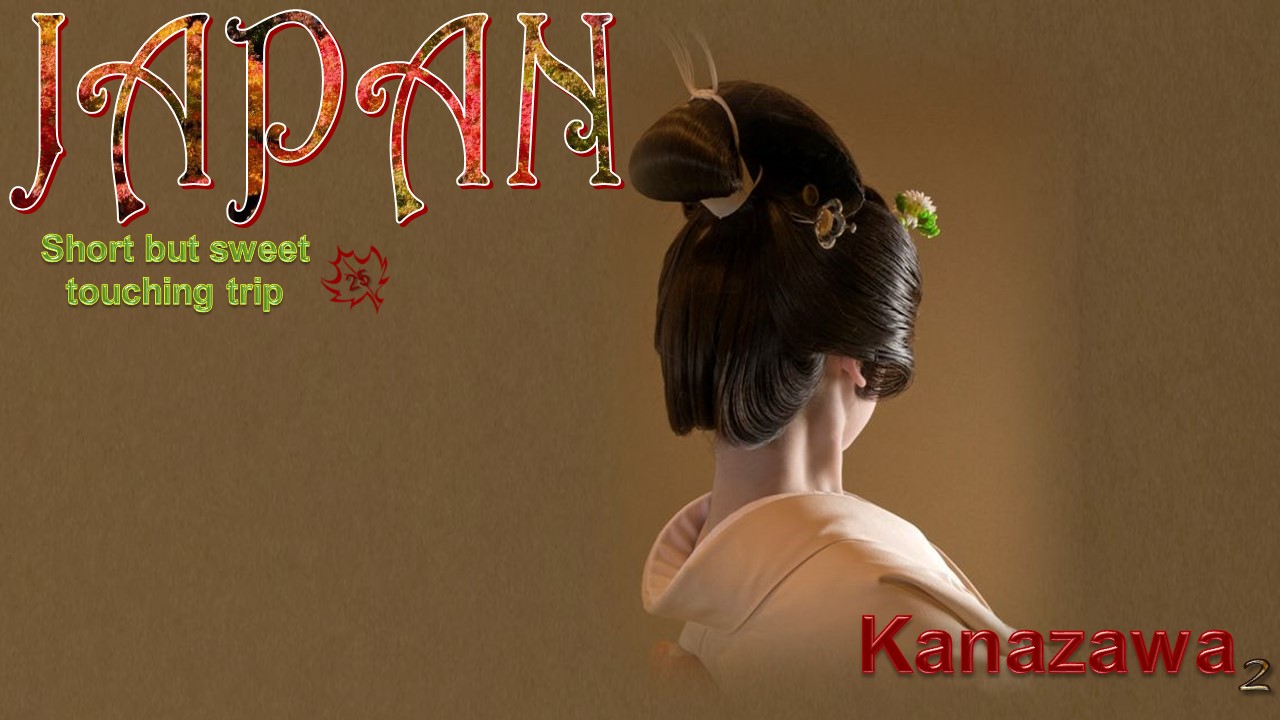Japan 25 Kanazawa 2 - PowerPoint PPT Presentation
Title:
Japan 25 Kanazawa 2
Description:
Ishikawa Prefecture’s capital, Kanazawa, was one of the few major Japanese cities to escape bombing by the US Air Force during World War II. Consequently, parts of the old castle town have survived intact, making the city a viable alternative to the more famous Kyoto for exploring traditional Japan. A chaya (lit. teahouse) is an exclusive type of restaurant where guests are entertained by geisha who perform song and dance. During the Edo Period, chaya were found in designated entertainment districts, usually just outside the city limits. Kanazawa has three, well preserved chaya districts, Higashi Chayagai (Eastern Chaya District), Nishi Chayagai (Western Chaya District) and Kazuemachi. – PowerPoint PPT presentation
Number of Views:1
Title: Japan 25 Kanazawa 2
1
JAPAN
Short but sweet touching trip
Kanazawa
2
2
Ishikawa Prefectures capital, Kanazawa, was one
of the few major Japanese cities to escape
bombing by the US Air Force during World War II.
Consequently, parts of the old castle town have
survived intact, making the city a viable
alternative to the more famous Kyoto for
exploring traditional Japan
3
A chaya (lit. teahouse) is an exclusive type of
restaurant where guests are entertained
by geisha who perform song and dance. During
the Edo Period, chaya were found in designated
entertainment districts, usually just outside the
city limits. Kanazawa has three, well preserved
chaya districts, Higashi Chayagai (Eastern Chaya
District), Nishi Chayagai (Western Chaya
District) and Kazuemachi. Of the three districts,
the Higashi Chaya District (Higashi Chayagai) is
the largest and by far the most interesting
4
(No Transcript)
5
(No Transcript)
6
Russian speaking .geisha
7
The willow tree marks the boundary point for
geishas during the Edo period. Geishas would wave
off their clients at the willow tree but were not
allowed to go past this point
8
(No Transcript)
9
The wooden buildings and paved streets are
reminiscent of the Edo Period
10
Yoshoku restaurant Jiyuken in Higashi Chaya
district has a history of 100 years
11
Koshi is a wooden lattice constructed with wood,
bamboo, or metal strips. By attaching a koshi
lattice, the inhabitants can look outside easily
during the day, but passers-by cannot see inside.
The styles of koshi depend on the profession of
the house owners, for example, the geisha houses
have different koshi (the unique, extremely fine
lattice work that is known as 'Kaga lattice)
12
(No Transcript)
13
(No Transcript)
14
(No Transcript)
15
(No Transcript)
16
Shima, a preserved tea house, which has been
converted into a museum. The rooms where geisha
would perform and the kitchen are on display
along with various instruments and items used by
the geisha
17
Shima Teahouse, Lantern rooflet
18
(No Transcript)
19
Ochaya Shima (Tea house), a 2 story preserved
geisha house turned museum
20
Ochaya Shima Museum
21
Ochaya Shima Museum Geisha, geiko or geigi are
traditional Japanese female entertainers who act
as hostesses and whose skills include performing
various arts such as classical music, dance,
games and conversation, mainly to entertain male
customers
22
Geisha like all Japanese nouns, has no distinct
singular or plural variants. The word consists of
two kanji, gei meaning "art" and sha meaning
"person" or "doer"
23
The most literal translation of geisha into
English would be "artist," "performing artist,"
or "artisan
Ochaya Shima Museum second floor
24
Another name for geisha is geiko, which is
usually used to refer to geisha from western
Japan, which includes Kyoto
25
Ochaya Shima Museum second floor
26
(No Transcript)
27
SHIMA is a chaya house built simultaneously with
the construction of the Higashi Chaya district in
1820
28
This house is a precious chaya construction that
has been designated as Japan's important cultural
asset
29
(No Transcript)
30
(No Transcript)
31
Hair adornments of a Geisha
32
(No Transcript)
33
(No Transcript)
34
Utagawa Kuniteru (18081876) The young maiden
Oshichi The Library of Congress, Washington, DC
35
Toshihide Migita, 1863-1925 Courtesan watching
the rain The Library of Congress, Washington, DC
Kaigetsudo Dohan (1710) Bijin-ga (Portrait of
courtesan in kimono adorned with a water mill
pattern)
36
Kiyomizu Komachi by Eizan Kikukawa The Library
of Congress, Washington, DC
Night rain at 10 pm (hikeyotsu) by Eizan Kikukawa
(1787-1867) The Library of Congress
37
Apprentice geisha are called maiko, (literally
"dance child") orhangyoku, "half-jewel" (meaning
that they are paid half of the wage of a full
geisha), or by the more generic term o-shaku,
literally "one who pours (alcohol)"
38
(No Transcript)
39
(No Transcript)
40
The scarlet-fringed collar of the brides kimono
hangs very loosely in the back to accentuate the
nape of the neck, which is considered a primary
erotic area in Japanese sexuality
41
(No Transcript)
42
(No Transcript)
43
(No Transcript)
44
Geisha performance
45
Geisha show in Kanazawa
46
Text Internet Pictures Sanda Foisoreanu
Nicoleta Leu Internet All
copyrights belong to their respective owners
Presentation Sanda Foisoreanu
2016
Sound Traditional Music of the Japanese
Geisha by Hideo Osaka Ensemble































